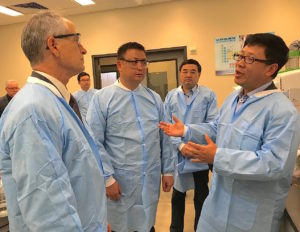China’s largest fertilizer manufacturer visits Texas A&M agriculture researchers
Media contact: Blair Fannin, 979-845-2259, [email protected]
Contact: Dr. Tim Herrman, 979-845-1121, [email protected]
COLLEGE STATION – China’s largest fertilizer company’s senior management and top distributors recently met with Texas A&M researchers in their first stop of a week-long tour to learn about U.S. agricultural practices.
The Stanley Agricultural Group visited Texas A&M to explore collaboration opportunities with Texas A&M AgrLife Research and the department of soil and crop sciences, according to Jinhau Gao, President of SAG.

In addition to being the largest fertilizer manufacturer and distributor in China, the Stanley Group is a complex full-service provider of agricultural services, including seed, pesticide, agricultural machinery, agricultural technology, food trade, finance and technical information.
“The objective of the visit was to begin to learn more about agricultural practices in the U.S. so that those practices can be implemented in China,” Gao said. “Specifically, the SAG is interested in increasing their knowledge of precision agriculture so that they can assist Chinese farmers in understanding the role of fertilizer to maximize economic gains while protecting the environment.”
This change is in response to agricultural consolidation resulting in large scale farms.
Fertilizer plays a key role in agriculture by increasing the production of staple crops, controlling fertility and reducing the risk to plants from pathogens and subsequent plant diseases. In 2016, U.S. imports of agricultural products from China totaled $4.3 billion.
“Developing contacts with Chinese stakeholders is crucial to the United States’ ability to ensure the safety of food and feed imported to the U.S. from China,” said Dr. Tim Herrman, state chemist and director of the Office of the Texas State Chemist and professor in the department of soil and crop sciences.
The state chemist office organized the visit as part of regulatory science outreach program.
“The main objective of the OTSC outreach program is to build a global learning community to help protect consumers and enhance agribusiness in the state of Texas,” Herrman said. “This community is comprised of: state, federal and international government regulators, food and feed industry personnel, laboratory personnel and other food/feed industry stakeholders.”
During their visit to Aggieland, the group of 230 visited a local farm and toured the OTSC laboratory. As part of the laboratory tour, the group was introduced to different procedures and instruments used to analyze fertilizer products for various nutrients.
Laboratory personnel discussed the importance of meeting label guarantees and ensuring that heavy metal contaminants in fertilizer do not exceed acceptable levels. Some of the distributors commented that this was their first visit to a state-of-the-art laboratory facility, and were excited to see how an accredited laboratory in the U.S. functions.
Herrman was joined by Ben Jones, associate director of the Office of the State Chemist and Dr. Tony Provin, professor and Texas A&M AgriLife Extension Service specialist in the department of soil and crop sciences. The meeting included a brief discussion of opportunities for collaboration.
Looking to the future, Herrman said the management of the Stanley Agricultural Group expressed an interest in the training programs offered by Texas A&M AgriLife, with the company’s goal of improving internal technical knowledge for better serving the farmers of China.
“Given the global nature of the food and feed chain, improvements in agriculture in China will be directly reflected in safer food and feed in the U.S.,” Herrman said.


